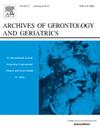Differing risk factors for potentially preventable and fall-related injury readmissions of older residents in long-term care facilities after hip fracture
IF 3.5
3区 医学
Q2 GERIATRICS & GERONTOLOGY
引用次数: 0
Abstract
Background
Although most fall-related injury readmissions are preventable, there may be differences between risk factors for other potentially preventable readmissions (PPR) and fall-related injury readmissions. This study examined the differences between risk factors for 30-day PPR and fall-related injury readmissions among older adults living in residential aged care facilities (RACFs) after a hip fracture.
Methods
This retrospective cohort study used linked hospitalization and mortality data in New South Wales, Australia. Residents aged ≥65 years who live in RACFs and were admitted after a hip fracture between 2014 and 2023. Demographic data, the number of Charlson comorbidities, and frailty risk were used. The 30-day PPR was identified using 22 conditions as defined by the Australian government, and three additional conditions (pressure injury, dehydration, sepsis). Multivariable logistic regression examined the predictors for 30-day PPR and fall-related injury readmissions.
Results
Among 12,335 residents, there were 266 residents who experienced PPR, and 361 residents who experienced fall-related injury readmissions. Although residents with one (odds ratios: 1.98, 95 % confidence interval: 1.50–2.61) or ≥2 comorbidities (2.38, 1.67–3.37) had a higher risk of 30-day PPR than residents without comorbidities, there was no association of comorbidities with 30-day fall-related injury readmissions. Frailty risk was not associated with 30-day PPR, but residents with high (0.58, 0.37–0.92) and moderate frailty risk (0.63, 0.40–0.99) were less likely to experience fall-related injury readmissions than residents with no frailty risk.
Conclusions
Targeted approaches for 30-day PPR and fall-related injury readmissions should be optimized based on their specific predictors for preventing 30-day readmissions.
髋部骨折后长期护理机构中的老年住院者因潜在的可预防和跌倒相关伤害而再次入院的不同风险因素
虽然大多数跌倒相关损伤再入院是可以预防的,但其他潜在可预防的再入院(PPR)和跌倒相关损伤再入院的危险因素可能存在差异。本研究调查了居住在老年护理机构(RACFs)的老年人髋部骨折后30天PPR和跌倒相关损伤再入院的危险因素之间的差异。方法:本回顾性队列研究采用澳大利亚新南威尔士州相关住院和死亡率数据。2014年至2023年期间髋部骨折入院的≥65岁的racf居民。使用了人口统计数据、查理森合并症的数量和衰弱风险。根据澳大利亚政府定义的22种情况和3种附加情况(压力损伤、脱水、败血症)确定了30天小反刍兽疫。多变量logistic回归检验了30天PPR和跌倒相关损伤再入院的预测因素。结果12335名居民中有266人发生过小反刍反应,361人发生过与跌倒有关的再入院。虽然有1个合并症(优势比:1.98,95%可信区间:1.50-2.61)或≥2个合并症(2.38,1.67-3.37)的居民发生30天PPR的风险高于没有合并症的居民,但合并症与30天跌倒相关损伤再入院没有关联。虚弱风险与30天PPR无关,但高(0.58,0.37-0.92)和中度虚弱风险(0.63,0.40-0.99)的居民比没有虚弱风险的居民更不容易经历跌倒相关损伤再入院。结论应根据30天PPR和跌倒损伤再入院的具体预测因素,优化有针对性的方法来预防30天再入院。
本文章由计算机程序翻译,如有差异,请以英文原文为准。
求助全文
约1分钟内获得全文
求助全文
来源期刊
CiteScore
7.30
自引率
5.00%
发文量
198
审稿时长
16 days
期刊介绍:
Archives of Gerontology and Geriatrics provides a medium for the publication of papers from the fields of experimental gerontology and clinical and social geriatrics. The principal aim of the journal is to facilitate the exchange of information between specialists in these three fields of gerontological research. Experimental papers dealing with the basic mechanisms of aging at molecular, cellular, tissue or organ levels will be published.
Clinical papers will be accepted if they provide sufficiently new information or are of fundamental importance for the knowledge of human aging. Purely descriptive clinical papers will be accepted only if the results permit further interpretation. Papers dealing with anti-aging pharmacological preparations in humans are welcome. Papers on the social aspects of geriatrics will be accepted if they are of general interest regarding the epidemiology of aging and the efficiency and working methods of the social organizations for the health care of the elderly.

 求助内容:
求助内容: 应助结果提醒方式:
应助结果提醒方式:


